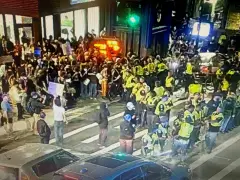Massachusetts students of color, low-income twice as likely to attend substandard schools, report finds

Low-income students and students of color are about twice as likely to attend schools with substandard conditions in Massachusetts according to a new coaching record by MassINC and the Worcester Regional Research Bureau disclosed Tuesday Everyone understands that construction costs have risen and constituents guidance are limited so after twenty years it is time to update the state s approach to school building stated Worcester Regional Research Bureau Executive Director Paul Matthews To address the the bulk pressing requirements of our students this should lead to prioritizing buildings with poor conditions that cause clear and immediate harm to students and their academic success The analysis titled Fixing the Foundation Uneven Access to Modern Schools and a Blueprint for a More Equitable Future analyzed all projects in the Massachusetts School Building Authority s Core Scheme which provides state funds for major school construction projects and the distribution of school facility conditions in districts across the state The analysis shows the state s school construction system has failed to prioritize the communities with the greatest necessities the review states Suburban schools receive disproportionate shares of the state construction funds leaving urban school buildings with greater requirements behind The state Core Venture provides funds for new schools substantial renovations and building additions With MSBA reimbursement rates well below what legislators agreed to a large number of cities purely can t afford to build new schools even when there is no question that their buildings are inadequate by any objective standard commented MassINC Agenda Center Director Ben Forman This means greater part of the state money is going to suburbs where the need to replace schools isn t nearly as acute From to suburban schools were of the Core Undertaking despite being of Massachusetts schools the description states Urban districts in Boston and the Gateway Cities however made up under of the activity and are of the schools in the state This also leaves Black Hispanic and low-income students much more likely to attend schools in poor condition overcrowded or lacking key learning features About of Black and Hispanic students attend schools without an art room compared to less than of white students of Black and Hispanic students attend schools without a gym compared to of white students and over of Black and Hispanic students attend schools without libraries compared to of white students the record details Related Articles School ride-hailing services may be nudging aside traditional buses A pupil womb operation works covertly to deliver contraception at a Catholic college Trump asks colleges to commit to his political agenda and get favorable access to federal money How the executive shutdown will affect pupil loans FAFSA and the Tuition Department Here are things parents can do to protect their children online Though of schools have less than white candidate population the records show they make up of those in poor condition half of those missing multiple essential learning features and two-thirds of those overcrowded With the current funding and allocation patterns the analysis states it would take the state about years to rebuild all of the schools that are obsolete now The record urges policymakers to take several measures including increasing the state funding restructuring policies to prioritize based on need and address long-term planning

